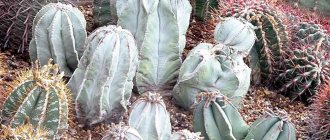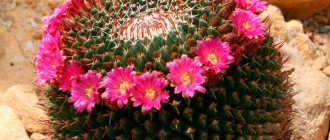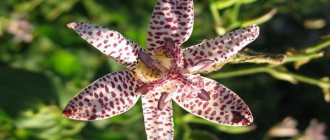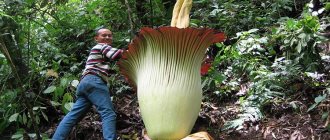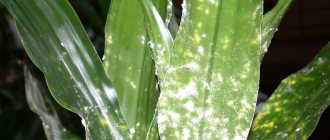Growing and care
The procedure for caring for astrophytums is traditional. The plant requires normal watering, fertilizing, protection from pests and diseases.
Watering
Astrophytum is one of those plants that is better to underwater than overwater. This cactus easily tolerates drought and can survive without water for up to a year. Optimal soil moisture regime:
- in summer - once a week;
- in spring and autumn - once every 15 - 20 days;
- In winter, astrophytum is not watered; you can lightly spray the plant’s needles every 30–40 days.
For irrigation, use settled or filtered water at a temperature of + 20 degrees.
Top dressing
Astrophytum is fertilized only in spring. The number of feedings is no more than 2 - 3, with a break of 25 - 28 days. Feeding rules:
- application after preliminary watering so as not to burn the roots;
- use of complex mixtures for cacti and succulents;
- reduction of the recommended concentration by 2 times.
The last feeding should be done no later than mid-August.
Transfer
Astrophytum does not like transplantation, so it should be done when the stem becomes crowded in the pot. A new container is selected with a diameter 3–4 cm larger than the previous one. When replanting, do not bury the root collar. This will cause the stem to rot.
Wintering
From the end of October to the end of February, the astrophytum is dormant. The optimal conditions for keeping the cactus at this time are temperature from + 5 to + 10 degrees and humidity 50 – 60%. It is impossible to provide such a regime of detention at home.
After wintering, the astrophytum is gradually accustomed to the sun and warmth. If you immediately expose the plant to light in a warm room, there is a risk of burns and stem rotting.
Types of cactus astrophytum
Astrophytums are succulents, that is, plants that can store moisture. The homeland of these particular cacti is the hot north of Mexico and the south of the USA. Outwardly, they resemble a ball, less often a cylinder.
Cacti at home
If you look at the plant from above, due to the presence of ribs (there can be from three to ten), it will resemble a star. That's why sometimes they call him that.
Interesting. These succulents have another name - “bishop's miter”. It was invented by people because of its external resemblance to this headdress.
Astrophytum is distinguished by the presence of specks on the surface. These specks are formed by special hairs that actively absorb moisture. Thorns rarely grow on such flora.
These cacti grow slowly. They have a long flowering period: from early spring to late autumn. The astrophytum flower itself does not live long - only up to three days.
Astrophytum
There are different types of this succulent. Everyone has their own difference.
Astrophytum Myriostigma
Astrophytum Myriostigma, or countless speckled, is the most famous type of these cacti. It has the shape of a gray-blue ball, with its top slightly pressed inward. A flower blooms on it in the flowering phase. Astrophytum myriostigma has six ribs. This species does not have spines, but it has a lot of specks.
In nature, it can reach a length of one meter; Astrophytum multistigma (another name for it) does not have a girth of more than 20 centimeters. It has many interesting varieties:
- Nudum. There are almost no points on this variety that should naturally absorb water. They still remain, but there are few of them; they already perform a strictly decorative function. The shape of the succulent is spherical, with moderately prominent edges.
- Kikko. These are cacti in the shape of a regular five-pointed star. They also have almost no speckles - a distinctive feature of the species.
Astrophytum Myriostigma Kikko
- Quadricostatus. Water-absorbing spots were not removed from this variety. But breeders have worked on the number of edges and shape of succulents. The plant now has four edges and a square shape.
Astrophytum stellata
Astrophytum stellata is the most common species in homes. They love it for its miniature size - in nature it can only reach 15 centimeters in diameter. House cacti are even smaller. Most often they have 8 ribs.
Astrophytum asterias (the scientific name of this succulent) has a scattering of specks on each edge. There are fewer of them, but they are larger than those of Myriostigma. At the same time, thorns do not grow on it either.
Interesting. This cactus interbreeds well with others, which is why there are many hybrid species. They may look similar to Astrophytum Asterias, but have, for example, spines or clearly structured spots. However, this is a sign that the culture is not pure, a mix of several species.
Astrophytum mottled
Astrophytum speckled has a smooth surface on which fleecy dots are scattered. It is very similar to the Myriostigma species, but has five facets. In open ground, the diameter of this succulent can reach 25 centimeters.
Astrophytum capricornus
Astrophytum capricornus is a cactus that has one of the most spectacular appearances. It got its name from the thorns that grow in rosettes on its edges. They are very long, curving upward, reminiscent of goat horns. In Latin, this plant is called astrophytum capricorne.
Astrophytum Capricorn
It can grow up to 17 centimeters in girth and 30 in height. It has eight edges and a small scattering of specks. Moreover, the points that absorb water are mainly located closer to the root or in the recesses between the edges.
Interesting. The spines of Astrophytum Capricorn are very fragile and easy to break. If the plant is not disturbed, by the age of 7-8 years it will be completely entangled in them.
Other types
There are a lot of cacti on the planet, all of them, one way or another, adapt to external conditions. This is the reason for such a variety of astrophytum species. It is not only nature that stimulates the emergence of new representatives of this genus. People are also working on creating new cacti. The set of methods by which new varieties and hybrids appear is called selection.
Less known, but still worthy of human attention, astrophytums:
- Ornatum. Astrophytum ornatum is the very first astrophytum discovered by man. The dots on it are not located all over, but in stripes, as if they were created artificially. This looks very unusual, which is why the succulent is nicknamed the decorated astrophytum. It grows spines, which are arranged in rosettes along the ribs of the plant. The ribs themselves are often straight, but they can also twist around the axis of the plant.
- Astrophytum Coahuila. The Latin name of this cactus is astrophytum coahuilense. It is abundantly covered with specks. Its distinctive feature is the ability to calmly tolerate higher temperatures. The plant feels normal even at 30 degrees Celsius.
- Astrophytum Jellyfish Head. This type of cactus has an unusual appearance. The thing is that the shape of astrophytum caput medusae (that’s what scientists call it) is neither a ball nor a cylinder. Its edges resemble tentacles, branching in different directions. Immediately after its discovery, it was allocated to a separate genus Digitostigma.
Astrophytum Jellyfish Head
Note! Mixed astrophytums are often sold in stores. Some people are mistaken in believing that this is the name of the variety. This is the name given to those cacti that combine at least three different types of astrophytums. Such plants can look completely different, depending on the combination.
Reproduction
Astrophytum seedlings @rosi.paolo, Flickr
Astrophytum practically does not form lateral shoots - children, so the seed method is used for propagation. Sowing is carried out at the end of February or the first ten days of March.
The optimal container for the procedure is a seedling greenhouse with a transparent lid. For germination, you need to provide a temperature of + 21..26 degrees. The first shoots appear after 10 – 15 days.
In the first 12 months, about 4 picking procedures are performed. After a year, their number is halved. When the diameter of the cactus reaches 20 mm, it should be transplanted into a separate container. Flowering of young astrophytums occurs after 4 – 6 years.
Picking seedlings of Astrophytum asterias f. Miracle kabuto @sunbird_cactus, Instagram
Caring for Astophytum at home
As a representative of the Cactaceae, Astrophytum has similar care needs as other cacti, apart from a few nuances. Let's tell you in more detail about growing this wonderful plant.
What soil is suitable for a cactus
Like most cacti, Astrophytum prefers rocky and sandy soils. Remember that the Astrophytum plant practically does not tolerate acidic types of soil. The optimal reaction is close to neutral or slightly acidic.
Collection of Astrophytums in a greenhouse
You can use ready-made cactus soil or mix your own mixture. Mix parts of regular houseplant soil, pumice (or perlite) and coarse sand. Make sure the final mixture is suitable by wetting and squeezing it. A crumbly lump of soil is exactly what you need.
Location of the cactus
When choosing a location for this cactus, give preference to well-lit areas. It is best to plant the bush on windows facing south. Sometimes in the summer it will be necessary to shade the crop to protect it from scorching rays.
Lighting
Astrophytum loves a lot of sunlight - at least 6 hours a day if it is outdoors. In the home, it is great for windows that receive direct sunlight or intense indirect light.
Temperature and humidity
Optimal temperatures for growing are within +20...+25°C. It is recommended to ensure a difference between day and night indicators. To do this, the flower pot can be taken out to an open loggia or terrace, leaving it at night. Such a bush should overwinter in a room where the air temperature will be approximately +10°C.
Astrophytums feel great in the summer
Also, do not forget to regularly ventilate the room so that there is enough fresh air. High humidity is not recommended for these plants. Astrophytum does not need to be moistened additionally; it prefers dry air.
Watering
Proper watering for the Astrophytum cactus is the main and important point. Try to overdo it with water. Astrophytum is watered moderately in summer. The soil must be completely saturated with moisture. Then the substrate should dry well. During the growing season, cacti stop growing during the day. Active absorption of moisture begins with the onset of darkness. Therefore, water in the morning or evening after 18:00.
Gardeners often use bottom watering because the soil can become very compact and the roots can rot. From autumn to spring you rarely need to water. One or two waterings throughout the cold season will serve the plant just fine.
Fertilizer
To feed the flower, use complex mineral substances intended for cacti (reducing the dosage by half). A single fertilization per month is sufficient for optimal development of the cactus. In winter it is better not to fertilize.
How to replant Astrophytum
The Astrophytum plant does not respond well to transplants, so this procedure should be resorted to in rare cases - only after the clod of earth is completely entangled in roots. When replanting a plant, it is not recommended to deeply immerse the root collar in the soil, as this can cause rotting. The landing container is used more than it was before.
Expanded clay or broken bricks are placed at the bottom of the container, and the soil is decorated with beautiful decorative stones on top.
Information on caring for succulents
How to prepare optimal soil for succulents: the best soil mixtures
What, how and when to fertilize succulents - expert advice
How to water succulents: what gardeners advise
Diseases and pests
If maintenance standards and care rules are violated, astrophytum can be affected by fungus or root rot.
The most common pests of the species:
- scale insect;
- mealybug
- root mealybug
If signs of infection appear, the cactus is washed with soapy water and then treated with Actellik. Replanting into new soil and washing the roots with an insecticide will help prevent rootworms.
Common subspecies and varieties of Astrophytum capricornus
There are many cultivars of this species. We will describe the most interesting and popular varieties.
Astrophytum capricorne var. minus
A small species that grows in the desert of Mexico. Characterized by a small stem, up to 12 cm in height, up to 8 cm in diameter with usually smaller and smaller white dots, like this type, never red. brown dots. The spines are thin and curved, covering the body.
Photo of Astrophytum capricorne var. minus
Magnificent flowers up to 10 centimeters in diameter, covering the entire body like an umbrella during flowering.
Astrophytum capricorne var. aureum
A plant with sharp ribs, which differs from the standard species in the absence of white spots. Grows in very dry areas.
Photo of Astrophytum capricorne var. aureum
Diurnal and seasonal temperature fluctuations are significant, and in winter, night frosts followed by hot temperatures on the same day are not uncommon. The spines are golden yellow when young, but become grayish with age, like other Astrophytums.
Astrophytum capricorne var. nudum
The stems are larger, bright green and almost glabrous (no white spots).
Photo of cactus Astrophytum capricorne var. nudum
The spines are very strong, up to 8.5 cm long, flat, black to brown, or (sometimes white or yellow) when young, later chalky gray.
Astrophytum capricorne var. niveum
This cactus variety grows in the more northern regions of Mexico (Chihuahuan Desert at an altitude of about 600 m above sea level). It has a strong, first spherical, then cylindrical stem, up to 50 cm in height, up to 20 cm in diameter. This variety was discovered only in 1930 in the north of the city of Cuatro Sinegas, the first description dates back to 1933 under the name Echinocactus capricornis v. Niveus.
Photo of Astrophytum capricorne var. niveum
A spherical plant that becomes columnar over time and can reach 50 cm in height. Its green stem is densely covered with fluffy white snowflake-like spots, from which it gets its name "Niveum", which distinguishes it from other varieties of the species.
The article uses materials from the resource plantsrescue.com
Possible problems
When growing astrophytum, the following problems may occur:
| Problem | Possible causes and solution |
| Stretching the stem | Too nutritious soil and excessive watering or lack of lighting. Plants need to be transplanted into a low-nutrient and maximally porous substrate. The pot must have a drain (tray) or 2-3 cm of pebbles at the bottom. Avoid overwatering. |
| Lack of flowering in adulthood | Wrong wintering. To lay flower buds, astrophytum needs to be kept during the dormant period at a temperature of no more than + 12 degrees. |
| Stem deformation | Lack of light or high temperatures in winter. You need to adjust the location and temperature. A severely deformed stem cannot be corrected. |
| Softening the base | Overmoistening of the soil. In the early stages of the development of the problem, replanting into new soil and lack of watering helps. A severely rotten stem cannot be saved. |
| Red spots on the surface | Rotting under the influence of moisture and too low a temperature. Damaged areas of the plant are cut off and sprinkled with charcoal. Such a plant cannot be restored to its former beauty, so it is worth growing a new specimen. |
| Corky spots on the surface of the stem | Pest infestation, injury or hypothermia. The cause may also be insufficient watering in summer or watering with lime water. |
Astrophytum capricornus
Growth:
Astrophytum capricornus is widespread in northern Mexico in the Chihuahuan Desert, where the amount of precipitation is much lower (less than 200 mm per year) than in the habitats of other Astrophytums. The cactus grows mainly on limestone soils, among rocks and thorny bushes.
IN THE PHOTO: The specific epithet Astrophytum capricornus was given for the characteristic shape of long and curled spines imitating blades of grass, which helps the cactus to be invisible in the environment.
Description of the plant:
Plant size and type:
Astrophytum capricornus is a single spherical or columnar cactus with a rather variable appearance (thorns, villi, growth). Young plants are spherical, soon become ovoid, and over time grow up to 1.2 m in height and 10–15 cm in diameter.
Stem:
The stem is dark green, covered with white woolly specks typical of this species.
PHOTO: New specks appearing on the top of the cactus are brown, then turn white.
Ribs:
There are usually eight ribs, they are high, and have sharp edges at the top of the stem.
Areolas:
The areoles are arranged in vertical rows along each rib.
Spines:
From 5 to 10 spines up to 7 cm long grow from each areola. The spines are gray to brown, curved, crooked and flat. Young plants do not have the spines characteristic of adult specimens.
IN THE PHOTO: As the cactus ages, the spines become slightly sharper and curved, but relatively few in number, hard, but flexible and brittle.
Flowers:
The flowers are 7.5 cm in diameter, yellow, with a beautiful dark red throat, and emit a sweetish aroma. They appear at the top of the cactus, at the base of young areoles.
IN THE PHOTO: In warm weather, the flower lasts only one day; under favorable conditions, it can bloom again the next day.
Flowering period:
Summer. Astrophytum capricornus blooms when it reaches the age of 3–4 years, if the growing conditions are favorable for it.
Fruits and seeds:
The fruits are 2.5 cm in diameter, covered with flat spines, when ripe they turn red and open at the bottom.
IN THE PHOTO: The seeds of Astrophytum capricornus are quite large, unevenly colored red or brown.
Agricultural technology:
This cactus is quite easy to grow, but grows slowly.
Temperature:
From spring to autumn, Astrophytum capricornus thrives at an average temperature of +16–24°C. From late autumn to the end of winter, the plant needs a dormant period at a temperature of +7–10°C.
For healthy cactus growth, good air circulation is necessary.
Lighting:
Astrophytum capricornus, like a desert cactus, loves the sun and grows well if it receives a lot of direct sunlight, although it can tolerate light shading. Young plants need to be slightly shaded. Due to lack of light, the cactus grows poorly and takes on an unnatural shape.
This Astrophytum cannot be grown outdoors except in regions where the climate is very similar to that of the species' natural habitat.
Watering:
During the period of active growth, the cactus should be watered moderately (usually once a week); in the intervals between waterings, the upper three-quarters of the soil should dry completely. During the dormant period, the plant is watered rarely, only to prevent the soil from drying out.
Fertilizer:
From spring to the end of summer, Astrophytum capricornus is fed with diluted fertilizer for cacti every four weeks. These cacti grow in poor soils and do not need large amounts of fertilizer. Excessive fertilizing can destroy the roots of the plant.
Substrate:
To grow a cactus, it is better to use a substrate consisting of one part coarse sand and two parts of any soil mixture . Good drainage is necessary, as the cactus is prone to rotting.
Young plants need to be replanted annually until they reach three or four years of age, after which replanting is carried out only if necessary. The cactus is replanted in early spring. If the roots are tightly entwined with an earthen ball, then you need to replant it in a larger pot. Otherwise, you need to plant the plant in the same pot with fresh soil mixture.
IN THE PHOTO: Gravel or small pebbles can be poured onto the surface of the soil in a layer of approximately 2.5 cm.
Diseases and pests:
Red spider mite:
They can be effectively destroyed by spraying the plant from above, or using an appropriate insecticide.
Mealybugs
Scale insects can sometimes be found on the body of a cactus among young spines and flowers, but it’s worse when they reproduce underground on the roots and are not visible, only the results of their activity are noticeable. It is necessary to regularly inspect the plant and occasionally water it with a systemic insecticide based on Imidacloprid.
Rot
Almost all problems arise as a result of waterlogging and poor ventilation, especially in cloudy, cool and very damp weather. With proper watering and good ventilation, the cactus is rarely affected by rot. To prevent fungal diseases, the cactus should be kept in a ventilated place, use a well-drained soil mixture and an appropriate size pot, and water the plant properly.
In case of severe rot, the cactus will have to be thrown away.
Reproduction:
Astrophytum capricornus can be propagated by seeds, since it rarely produces shoots. Seeds are sown in spring in pots with fine sandy soil with good drainage, sprinkled with a thin layer of sand and watered from below with the addition of a fungicide to prevent the death of seedlings from fungal diseases. The temperature should be around +21–27°C. To maintain high humidity, the pot should be covered with a transparent glass or plastic lid for 1–2 weeks, after which the lid should be replaced with a light cloth. Over the next two weeks, you need to spray the seeds once or twice a day, by which time most of them should germinate. Further spraying should be reduced to once every two, and then every three days.
IN THE PHOTO: The seedlings should not be touched until they are well rooted, after which they can be planted individually in small pots.
Sometimes this cactus is grafted to avoid root rot.
Astrophytum, grafted onto a hardy rootstock, grows easily and caring for it does not require any special skills. Editorial team LePlants.ru
Kinds
Astrophytum Asterias (Stellate)
Astrophytum Myriostigma (Speckled)
Bibliography:
- Cacti and succulents: Illustrated Encyclopedia / Anderson M. - M.: Niola 21st century, 2002, - 264 pp.: ill.
- Thorn: how to create a green oasis at home. Amazing cacti and succulents / Zhinel Leon. — M.: Eksmo, 2022.— 224 p.: ill.
- Special issue of the newspaper “My Favorite Flowers” No. 11, 2013
Astrophytum ornatum: botanical description
Astrophytum ornatum is a slow-growing, resilient member of the Cactus family. This houseplant is also . The name of the genus comes from Greek words and is translated as plant star.
Astrophytum Ornatum is native to the hot regions of the southern United States and Mexico. It is the very first representative of the Cactus family of its genus. It was found by Dr. Thomas Kulte near the Barranca de Venados valley.
Astrophytum Ornatum is a beautiful and unusual cactus with a spherical gray-green stem that stretches over time. The surface of the stem is covered with silvery specks. The spines are hard and straight. Astrophytum Ornatum blooms with light yellow flowers. The fruits are green with brown seeds inside.
Astrophytum photo
Astrophytum capricorne
Astrophytum_asterias
Astrophytum caput-medusae
Astrophytum ornatum
Astrophytum myriostigma
Astrophytum coahuilense
Description of the flower
Astrophytum is native to Mexico. Its name is translated as “plant star”.
It has the shape of a cylinder or ball, usually with a small, low shape. The photo of the astrophytum shows that its flower resembles a starfish in shape. Because of this similarity, it got its name.
There are small hairy patches on the stem of the atrophytum plant. With the help of these inclusions, the flower draws in moisture. The color of the stem is from green to bluish.
With proper care indoors, the cactus pleases with its flowering in mid-summer. Most often there is one flower, less often – several. Flower color is cream or yellow. You can admire the blossoming cactus for only a short time - only 3 days. After this, a box with seeds is formed from the flower.
Reproduction of astrophytum by seeds
The seeds are large, 2-3 mm in diameter, chestnut or black in color. The optimal sowing period is the 3rd decade of February.
The reproduction process has 2 stages:
- sowing grains;
- caring for seedlings.
Sowing seeds
Available materials:
- flower pot or other container, top diameter approximately 10cm, height 3-7cm;
- plastic bag;
- agro-soil composition: vermiculite, charcoal, leaf humus (1:1:2). The composition must be sterilized.
Fill the pot with substrate and water it. The interval from the top layer of the substrate to the edge of the pot should be at least 15 mm. The seeds are sown evenly and do not sprinkle the substrate on top. A plastic bag is placed over the pot.
Conditions for seed germination:
- air humidity (100%);
- bright diffuse lighting;
- daily ventilation;
- temperature (20–30 C).
The germination period of the main number of seedlings (up to 80%) ranges from 1 to 4 weeks. The first seedlings can germinate on the third day. Germination depends on the period and conditions of seed storage.
Varieties of Astrophytum
There are many types of Astrophytum in nature. They are not much different in care, but they are diverse in appearance, so you need to choose the variety carefully, based on the features of the interior and your own preferences. Common types of indoor Astrophytum:
- Star cactus is the most popular of all types of this cactus. It grows extremely slowly and has no thorns at all. Consists of five segments of identical shape and size. Flowers bloom in the center, in the hollow between the “rays”, 3-5 pieces at a time. The color of the petals is often pastel yellow. The pistils and stamens are bright orange.
- Astrophytum capricornus is similar to its stellar counterpart, but its stem has not 5, but 7 segments. In addition, the skin of the cactus is completely covered with white spots, due to which it lives longer without additional moisture, because it accumulates it better. The capricorn subspecies produces one flower at a time, but it is large in diameter - up to 15 cm. The color of the petals is soft yellow, and the center is red-orange.
- Speckled gets its name from the spots on the skin of the stem. They look like small white dots. This cactus has 4 segments in the stem, but they are large and elastic. In the hollow between them one bright yellow flower blooms, whose petal structure is similar to a chrysanthemum.
- Astrophytum ornate (ornatum) is the fastest growing of the species of this cactus. It has small but sharp spines that are arranged in groups. It is also considered the tallest of the astrophytums (it can grow up to 30 centimeters). Unfortunately, this subspecies does not bloom in indoor conditions.
- Multistigma (Myriostigma, thousand-speckled ) is one of the first discovered varieties of this plant. It differs from other species in its diversity. The number of its segments varies from 4 to 7. It blooms with large flowers with white-yellow petals.
- Astrophytum Capricorn. Non-flowering species. It stands out due to its needles, which have a curved, rounded shape. Large variety, can reach 25 centimeters in height.
- Astrophytum Asterias super (Kabuto) is certainly one of the most exotic varieties. It has no needles at all. Instead, there are whitish spots on the skin of the cactus. Kabuto produces only one flower from his upper central hollow. The color of the petals varies from soft beige to lemon yellow.
Description of astrophytum
As a rule, astrophytums form a rounded, symmetrical trunk with pronounced or faintly noticeable ribs. It has a brownish-green color and is covered with characteristic light specks and spots formed by tufts of small hairs. Most astrophytums are not distinguished by large needles and sometimes lack them completely. Such species sometimes resemble ribbed grayish stones more than plants. Astrophytums bloom in summer. At this time, large single flowers of yellowish or white color appear at the top of the plant. In some varieties of the plant, the petals are colored red-orange on the inside. The flowers stay on the cactus for only a few days, and then turn into fruits of gray, pink or reddish color.
Astrophytum - star cactus...Astrophytum.
general description
The Astrophytum cactus was brought to Europe from the hottest areas of Texas, where the microclimate is sometimes even harsher than in the desert due to irregular dew and disturbed soil. This plant has many forms and types, which differ in the size of the stem and needles, flowers, and the shape of the inflorescences.
The trunk of the star cactus consists of several segments that form a pointed star when viewed from above. Depending on the variety, it may have 5, 6, 7 or 8 rays. A larger number of segments is extremely rare.
Astrophytum, like other cacti, has leaves that have turned into needles over time. The spines are brown, long and sharp - this is a distinctive feature of the species.
The dark green skin of Astrophytum is covered with light, white felt specks. These spots are needed to absorb moisture as much as possible. Without them, the plant would not survive in the harsh Texas climate.
Blooming Astrophytum is a common occurrence. This type of cactus produces buds early. Flowers, if the plant is properly cared for, will delight the gardener from March to November. Most often, the color of the petals is bright yellow, sometimes interspersed with red and orange. The lifespan of each individual flower is short - about 3-5 days.
Basic rules of care
Temperature. Astrophytum Ornatum tolerates summer temperatures of +22-+28°C well. In winter, the temperature is needed in the range from +8 to +9.- Watering. Astrophytum Ornatum requires moderate watering in summer. In winter, they stop watering it altogether. Astrophytum Ornatum is very sensitive to waterlogging.
- Light. Astrophytum Ornatum loves light very much. Requires bright, intense lighting, direct sunlight is possible, but it is better if it is diffused light.
- Soil and pot. The pot is better to be ceramic.
It should also have plenty of drainage holes. Drainage is required at the bottom of the pot. The soil should be very slightly acidic, closer to neutral. A soil mixture of coarse-grained substrate, peat chips, clay soil, gravel and sand is suitable. Attention! Astrophytums do not tolerate too acidic soil. - Trimming. Plant forming pruning is not performed on Astrophytum Ornatum. The plant is pruned only if it rots. In this case you need:
- Trim off all rot to a completely clean cut with a sharp knife.
- And then treat with a disinfectant solution, for example, alcohol.
- After this, stop watering the cactus until it is completely restored.
- Feeding. From mid-spring to mid-summer, Astrophytum Ornatum is fed with fertilizers every three weeks. To do this, use special fertilizers for cacti.
- Transfer. Young specimens of Astrophytum Ornatum are replanted annually for the first 4 years. Transplantation is carried out in the spring.
- For transplantation, a ceramic container is selected according to the size of the root system. It should also have plenty of drainage holes.
A drainage layer of gravel about 2-3 cm high is poured onto the bottom of the pot.
- The plant is transferred from the old pot to the new one. At the same time, the root ball is not destroyed.
- Wintering. In winter, it needs additional lighting and a temperature of 8-9 degrees.
It is not recommended to replant adult Astrophytums.
Growing problems
- The edge of the stem wrinkles, and the trunk itself becomes soft from below - excess moisture. It is necessary to reduce watering.
- Growth stops - in the summer season, watering is too rare, or too intense in the winter.
- Brown spots appear - incorrect watering, which provoked the appearance of stem rot. In this case, carefully cut off the area affected by rot, after which the substrate is disinfected. Normalization of hydration is definitely required.
- The stem configuration is arched - there is not enough light, or the temperature is too high during the winter season.
